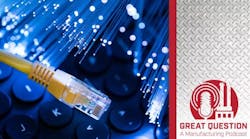Podcast: The Myths of Fiber Optic Cables
In the evolving landscape of the Industrial Internet of Things (IIoT), connectivity and data transmission hinges on using the right cables for each application. As the industry becomes more automated and data-driven, it’s important to understand the different types of fiber cables and their associated costs. Join Laura Davis, Editor-in-Chief of New Equipment Digest as she discusses common myths about fiber cables, including their installation, costs, performance, and reliability for IIoT applications.
Below is an excerpt from the transcript:
With industrial Internet of Things (IoT) networks constantly changing and evolving, understanding the ins and outs of fiber optic cables is needed for IT technicians and plant managers alike.
Although fiber has been around for more than four decades, many misconceptions remain. At the top of the list is that installing fiber optics is more expensive than copper due to its networking devices, terminations, and cables. Another is that fiber is harder to install and terminate than copper. Last, there's the fallacy that fiber cables are fragile since they're "made of glass".
We'll dispel those lingering myths here.
Fiber optic cables are the fastest-growing transmission medium for both new network builds and expansions, especially in applications that require high bandwidth, long distances, and immunity to electrical interference. Network backbones transmitting huge amounts of bandwidth-consuming data files almost exclusively rely on fiber.
As the name implies, fiber optic cables carry optical signals using fast-traveling pulses of light instead of electricity over long distances. At the cable's core are extremely pure glass fibers the same width as human hair that transmit light photons down the length of the cable.
A layer of glass cladding surrounds the core to guarantee that light is reflected, rather than leaking out at the edges, enabling the signal to travel longer distances without attenuation. Over the cladding is a buffer that keeps the cable's internal glass structure safe from damage and prevents excessive bending. An additional layer of reinforcing fibers shields the core, followed by a rugged plastic jacket.
Fiber is far from fragile. The strength members of fiber cables protect against crushing blows, bending forces, and, of course, the pulling tension encountered during installation. Reinforcing around the core keeps the cable stiff to maintain the allowable cable-bend radius and prevent kinking when pulling around corners. Once installed, fiber optic cables are sturdier than copper with fewer parts. In fact, a fiber optic cable can last up to 50 years, withstanding extreme temperatures, high shock, moisture, and vibration without degrading.
All this doesn't mean careless installation won't damage fiber optic cables. Exceeding bending radius limits or kinking the cable will lead to micro-cracks that increase the potential for degradation. Poorly spliced cable will give rise to fiber movement if splice materials have different characteristics than the cable, such as different thermal expansion coefficients. Malfunctions in fiber optic networks are virtually always due to poor installation, misaligned fusions, or accidental cuts.
Despite the built-in mechanical protection in modern fiber optic cables, some industrial or outdoor plant installations require more protection. In these instances, armored cables are recommended.
Armored fiber optic cables are manufactured to handle abrasion, impact, UV damage, and are designed for underground direct burial out of the box. Armored cables can be a cost-effective alternative to running the cable through a protective conduit. Conduit installation costs are incurred twice: first, when installing the conduit, and second, when installing the cables, hence doubling labor and material costs. Armored cables cost more than standard fiber cables but the labor to install them is considerably less.
